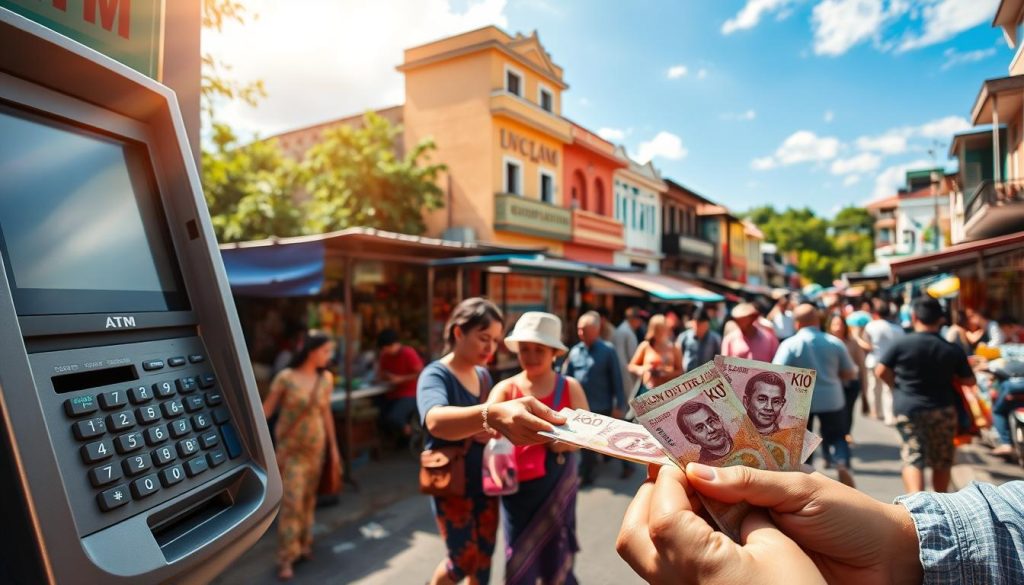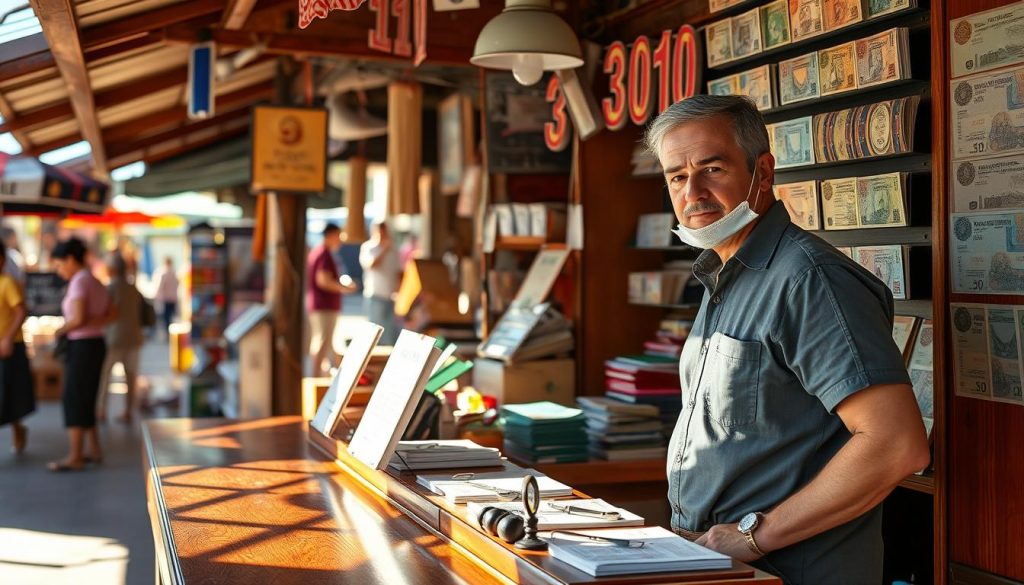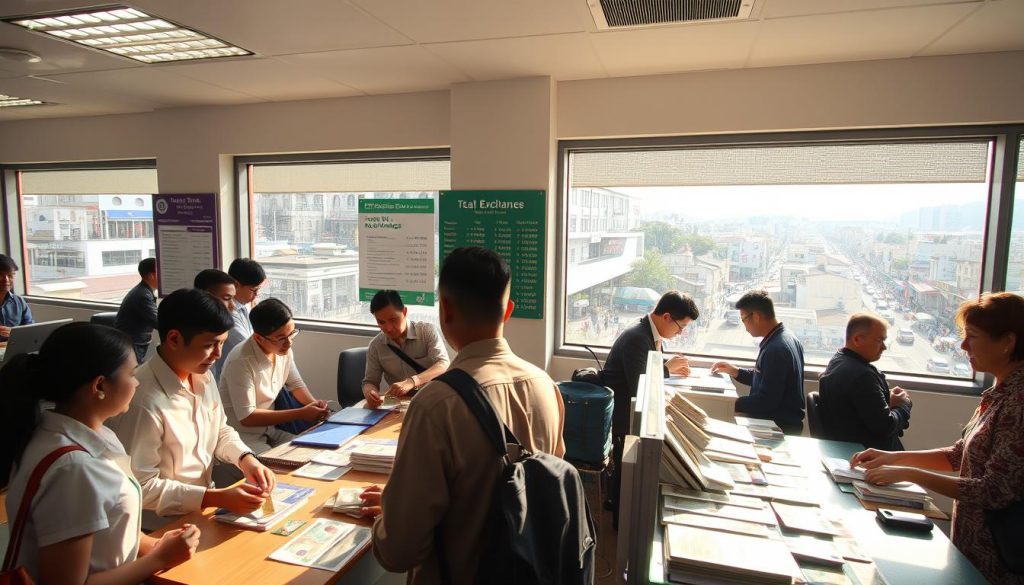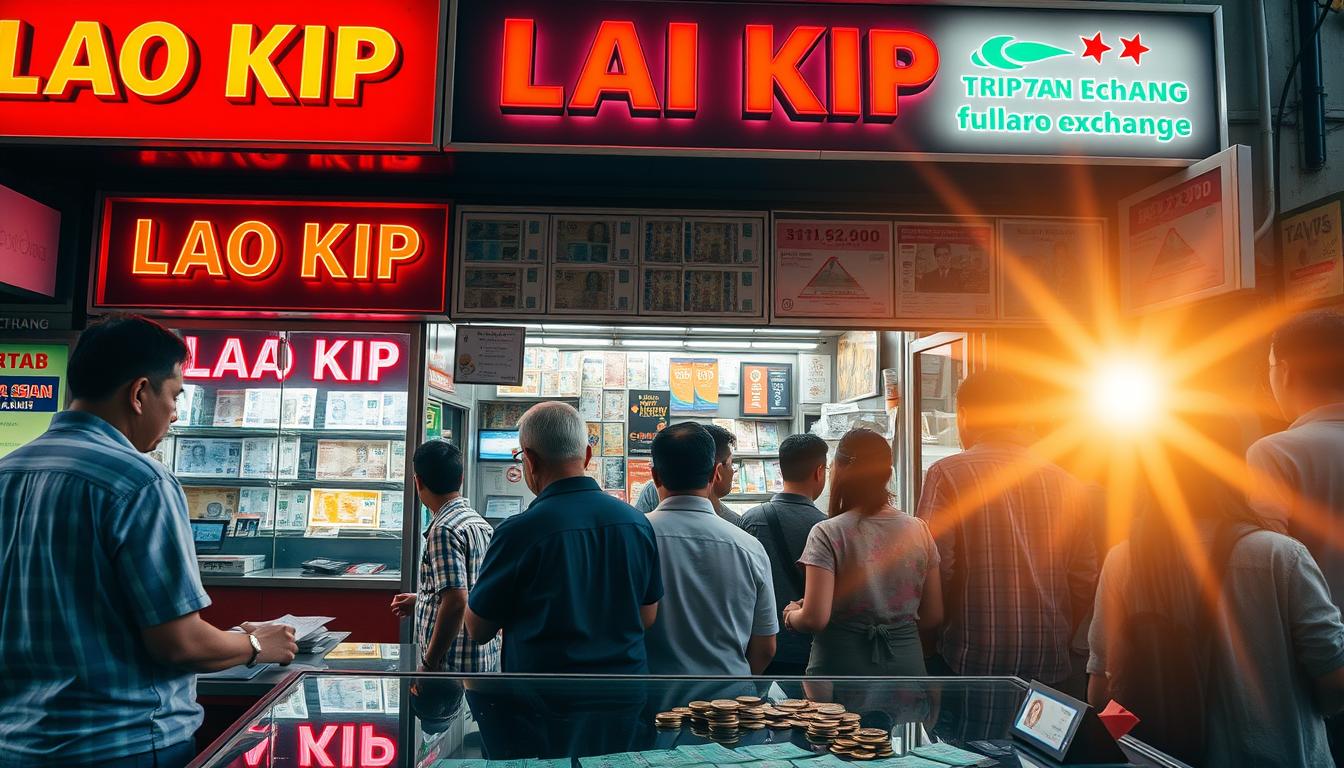Did you know that as of today, 20,887 Lao Kip equals just one US Dollar? This surprising exchange rate highlights the unique financial landscape you’ll encounter when visiting this Southeast Asian destination. Understanding the local currency is key to making the most of your trip.
The official currency is the Lao Kip, symbolized as ₭. While US Dollars are accepted in some tourist areas, using the local currency often ensures better value. This guide will help you navigate banknotes, exchange options, and payment methods like cash and card.
You’ll learn where to get the best exchange rate, from banks to licensed money changers. Plus, we’ll share tips to avoid common pitfalls and manage your money effectively. Whether you’re planning your budget or exploring local markets, this guide has you covered.
Understanding Laos Currency and Official Notes
Understanding the Lao Kip is your first step to hassle-free transactions. The official currency, symbolized as ₭, comes in various banknote denominations. Knowing these details helps you manage your money effectively during your stay.
Lao Kip: Banknotes and Denominations
The Lao Kip is issued in banknotes ranging from 500₭ to 100,000₭. Smaller denominations like 1,000₭ and 5,000₭ are particularly useful for everyday purchases. Larger notes, such as 50,000₭ and 100,000₭, are ideal for bigger expenses.
Here’s a quick breakdown of the available denominations:
| Denomination | Common Uses |
|---|---|
| 500₭ | Small snacks or tips |
| 1,000₭ | Street food or local transport |
| 5,000₭ | Meals at casual restaurants |
| 20,000₭ | Entry fees or souvenirs |
| 100,000₭ | Accommodation or tours |
No Coins in Circulation
Unlike many other currencies, the Lao Kip does not include coins. All transactions are handled using banknotes. This means you’ll need to carry smaller notes to avoid issues with change, especially in rural areas.
For example, paying with a 100,000₭ note for a 10,000₭ purchase might leave vendors struggling to provide change. Carrying a mix of denominations ensures smoother transactions.
“Having smaller bills on hand makes it easier to interact with local traders and avoid awkward situations.”
By familiarizing yourself with the Lao Kip and its banknotes, you’ll be better prepared for daily transactions. This knowledge is especially helpful when exploring markets or rural areas where cash is king.
Exchanging Money in Laos: Banks, Booths, and Hotels
Exchanging currency efficiently is a key part of planning your trip to Laos. Knowing where to exchange money can save you time and avoid unnecessary fees. Whether you choose banks, licensed booths, or hotels, each option has its pros and cons.

Exchanging at Banks
Banks are one of the safest options for currency exchange. They offer official rates and require a passport for transactions. Most banks operate Monday to Friday, from 8:00 AM to 4:00 PM, with some branches open on Saturdays.
Here’s why banks are a reliable choice:
- They provide secure transactions with minimal risk of fraud.
- Exchange rates are consistent and transparent.
- You can convert major currencies like USD, EUR, and THB.
However, banks may have longer wait times and limited hours compared to other options.
Currency Exchange Booths
Licensed currency exchange booths are a convenient alternative. They often offer competitive rates and have longer operating hours. You’ll find these booths in bustling cities and tourist areas like Vientiane and Luang Prabang.
Here’s what to consider:
- Rates can vary, so compare before exchanging large amounts.
- Booths are faster and more accessible than banks.
- Always verify the amount received to avoid errors.
“Comparing rates at different booths ensures you get the best deal for your money.”
While booths are convenient, they may charge higher fees than banks. For the best experience, exchange only a small amount at airports and find better rates in the city.
Payment Options in Laos: Credit Cards, ATMs, and More
Navigating payment methods in Laos is easier than you might think. Whether you’re withdrawing cash or using a credit card, knowing your options ensures a hassle-free experience. This section covers everything from ATM availability to where cards are accepted.

ATM Withdrawals and Banking Hours
ATMs are widely available in major cities like Vientiane and Luang Prabang. They dispense only Lao Kip, with daily withdrawal limits ranging from 1 million to 3 million ₭. Most machines operate 24/7, but those inside bank branches are accessible from 9 AM to 3 PM.
Be aware of fees, which typically range from 20,000 to 40,000 ₭ per transaction. For larger amounts, visit a bank during working hours. Carrying a mix of cash and cards ensures you’re prepared for any situation.
Credit Card Acceptance in Major Establishments
While cash is king in rural areas, credit cards are accepted in upscale hotels, restaurants, and shops. Visa and Mastercard are the most widely recognized. Some establishments may display bills in Lao Kip, Thai Baht, or USD for convenience.
However, always carry cash for smaller vendors and local markets. As one traveler noted,
“Having both cash and cards gives you flexibility and peace of mind.”
By understanding these payment options, you can enjoy a seamless experience while exploring Laos. Plan ahead, and you’ll avoid any financial hiccups during your trip.
Tips for Getting the Best Exchange Rates in Laos
Getting the best exchange rates during your trip can save you money and make your experience smoother. Whether you’re exchanging cash or using a credit card, a little planning goes a long way. Here’s how to ensure you get the most value for your money.

Monitor the Mid-Market Exchange Rate
Start by keeping an eye on the mid-market rate. This is the real exchange rate banks use, and it’s often better than what you’ll find at airports or hotels. Use online tools like currency converter apps to track it daily.
Here’s a simple strategy:
- Check the rate before your arrival to set a budget.
- Compare rates at different service providers before committing to a transaction.
- Avoid last-minute exchanges, as rates can fluctuate.
Avoid High Fees at Airports and Remote Areas
Airports are convenient but often charge higher fees. Exchange only a small amount for immediate needs, like transportation. Save larger transactions for city centers, where rates are more favorable.
Here’s why:
- Airport exchanges have captive markets, leading to markups.
- Remote areas may lack competitive service providers.
- Hidden fees can quickly add up, reducing your money’s value.
“Always compare rates and fees before exchanging. It’s the easiest way to stretch your budget.”
By following these tips, you’ll maximize your money and enjoy a stress-free trip. Plan ahead, stay informed, and you’ll avoid common pitfalls that can eat into your travel funds.
Laos: Ultimate Travelers Guide to Currencies & Payments – Your Must-Know Strategies
Planning your financial strategy before your trip can make all the difference. By preparing ahead, you’ll avoid unnecessary stress and save money. This section covers essential tips to help you manage your currency needs and make the most of your travel budget.

Plan Your Currency Needs Before You Travel
Start by estimating your daily expenses. Knowing how much LAK you’ll need helps you budget effectively. Exchange a small amount of USD to LAK before departure to cover immediate costs like transportation or tips. This ensures you’re prepared from the moment you arrive.
Here’s why planning matters:
- You’ll avoid high fees at airports or hotels.
- Having local currency on hand simplifies transactions.
- It reduces the risk of running out of cash in remote areas.
Utilize Multi-Currency Travel Cards for Better Rates
Multi-currency travel cards, like the Wise Multi-Currency Card, are a game-changer. They allow you to lock in favorable rates and avoid foreign transaction fees. These cards are widely accepted and offer flexibility for payments in LAK, USD, or even Thai Baht.
Here’s how to make the most of them:
- Load your card with the currencies you’ll need.
- Use apps to track real-time exchange rates.
- Compare the convenience of digital cards with local banks.
“A multi-currency card simplifies payments and ensures you get the best rates wherever you go.”
By combining these strategies, you’ll enjoy a seamless financial experience. Plan ahead, stay informed, and make smart choices to maximize your travel budget.
Unique Payment Insights for Traveling Beyond Vientiane
Exploring the countryside offers a unique experience, but managing your finances can be tricky. Outside major cities like Vientiane, cash in LAK is often the only accepted form of payment. This makes planning ahead essential for a smooth journey.
Managing Cash in Remote Areas
When traveling to smaller towns or rural areas, cash is king. ATMs and credit card facilities are scarce, so carrying enough local currency is crucial. Here’s how to handle your money effectively:
- Carry smaller denominations for everyday expenses like food and transport.
- Store cash in multiple places to minimize loss or theft.
- Plan your budget carefully to avoid running out of funds in remote areas.
Finding a best place to exchange money can be challenging outside tourist centers. Licensed booths or banks in larger towns are your safest bet. Avoid relying on informal exchanges, as rates may not be favorable.
“Carrying extra cash for emergencies is always a good idea. You never know when you’ll need it in less accessible areas.”
By preparing ahead and managing your cash wisely, you’ll enjoy a stress-free adventure beyond the bustling city centers. Whether you’re exploring hidden gems or remote villages, these tips ensure you’re always ready.
Conclusion
Managing your finances while traveling doesn’t have to be stressful. This guide has covered everything from understanding the local currency to finding the best exchange rates. Whether you’re using dollars or multi-currency cards, planning ahead ensures a smooth experience.
Always carry enough local cash, especially when arriving at the airport. While dollars are accepted in some places, having smaller denominations of the local currency is essential for daily transactions. Monitoring exchange rates and avoiding high fees at the airport can save you money.
Review the tips and strategies shared here to make your trip hassle-free. With proper preparation, you can explore with confidence and focus on enjoying your journey. Happy travels!
The above is subject to change.
Check back often to TRAVEL.COM for the latest travel tips and deals.
Here are some Tours & Sightseeing suggestions that might pique your interests!




